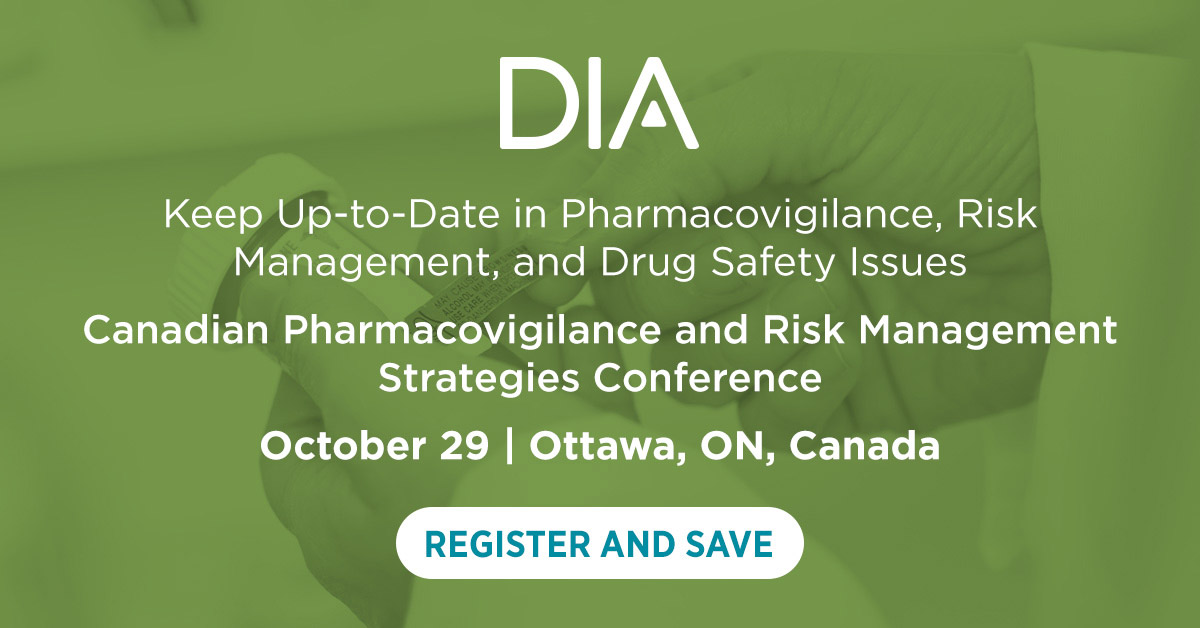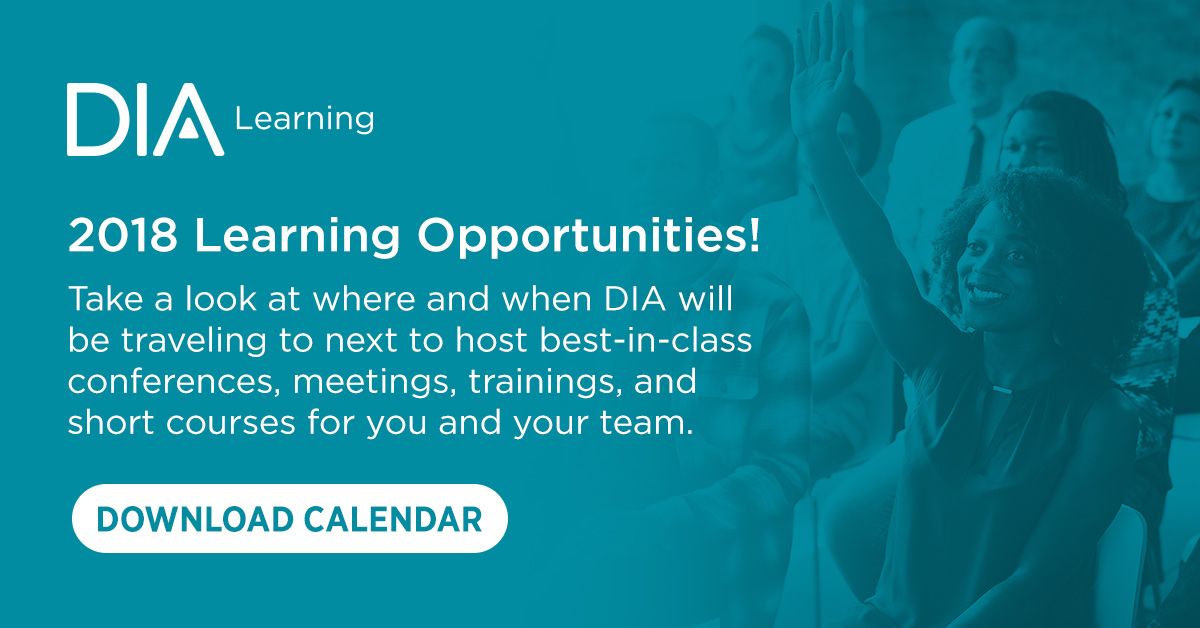September 2018 Global Forum
Table of Contents
EXECUTIVE LEADERSHIP
Subscribe
Love Global Forum‘s new online format? Subscribe today and never miss an issue.
Executive Leadership | DIA Leadership Message
On July 1, 2018, Dr. Joseph Scheeren (Senior Advisor, R&D, Bayer) became Chair of the DIA Board of Directors. “In this time of great change, it is great to be part of an organization like DIA, which wants to bring stakeholders together in order to discuss and foster the development of new products and new technologies,” he explains. “We have a unique opportunity not only to bring these stakeholders together but also to serve as a platform for information for our members and even beyond our members.”
Executive Leadership | Editor’s Message
September 2018
A Chair For Our Age

Alberto Grignolo
Editor
Fellow of DIA
r. Joseph Scheeren is no stranger to international travel. The new Chair of the DIA Board of Directors may have spent as many years globe-trotting as he has spent working in an office.
During a 36-year career in pharmaceutical regulatory affairs and drug development in positions of increasing regional and worldwide responsibility, he has worked and resided for years at a time in Europe, in the United States, and in China – all the while shuttling among Continents for meetings and speaking engagements all over the world. The man is tireless; his work has always been world-class.
Listen to our recent podcast interview with Joseph and you will get a clear sense of our new Chair, who was envisioning the role of AI in Regulatory Affairs years before anyone else even thought of such an association. He sees beyond the visible horizon.
Editorial Board
Content stream editors
Translational science
Gary Kelloff US National Institutes of Health
David Parkinson ESSA Pharma, Inc.
regulatory science
Yoshiaki Uyama Pharmaceuticals and Medical Devices Agency (PMDA)
Adora Ndu BioMarin Pharmaceutical, Inc.
Patient engagement
Deborah Collyar Patient Advocates In Research (PAIR)
Lode Dewulf Servier
Value & access
Edith Frénoy European Federation of Pharmaceutical Industries and Associations (EFPIA)
Sean Tunis Center for Medical Technology Policy (CMTP)
Editorial Staff
Alberto Grignolo, Editor PAREXEL International
Ranjini Prithviraj, Senior Managing Editor, Associate Director DIA Publications
Sandra Blumenrath, Science Writer DIA Publications
Chris M. Slawecki, Senior Digital Copyeditor DIA Publications
Regional Editors
AFRICA
David Mukanga Bill and Melinda Gates Foundation
ASEAN
Silke Vogel Duke-National University of Singapore Graduate Medical School
AUSTRALIA/NEW ZEALAND
Richard Day University of New South Wales, Medicine, St Vincent’s Hospital
CANADA
Judith Glennie JL Glennie Consulting, Inc.
Megan Bettle Health Canada
CENTRAL AND SOUTH AMERICA
Jaime Oliveira Bayer S/A
CHINA
Ling Su Shenyang Pharmaceutical University, Lilly Asia Ventures
EUROPE
John Lisman Lisman Legal Life Sciences
INDIA
J. Vijay Venkatraman Oviya MedSafe
JAPAN
Junichi Nishino Novartis
US
Ann Meeker-O’Connell IQVIA
DIA Membership
Bringing together stakeholders for the betterment of global health care.
New Regulatory Tools in the Fight Against the Opioid Crisis
Progress from Canada
Megan Bettle
Director, Regulatory Reform
of Drugs and Devices
Health Canada
ver the past several years, opioid overdose deaths have increased substantially in Canada. Data released in June 2018 showed that there had been almost 4000 opioid-related deaths in Canada in 2017, rising from around 3000 in 2016. The highest rates on a population basis are in western regions such as British Columbia, Alberta and Yukon, but the new data show clearly that the opioid crisis is a broad national problem. Similar increases have also been seen in the United States.
The North American opioid crisis is complex. What was initially viewed as an issue linked primarily to the problematic misuse of prescription medicines and thought to have roots in over-prescribing, has been made worse by the unpredictable and potent drug content of illegal opioids. Fentanyl and similar powerful synthetic opioids are inexpensive to make and easy to ship in small volumes, and have been identified in a high proportion of the illegal drug supply.
Expedited Regulatory Pathways in Established and Emerging Markets
Cristina Mota
Director
Scientific Regulatory Policy & Intelligence, Latin America
AbbVie
Jarbas Barbosa
Former Director-President
ANVISA
Lawrence Liberti
Executive Director
Center for Innovation in Regulatory Science
Denise Bonamici
Head
Regulatory Science & Policy, LATAM
Sanofi
Alberto Grignolo
Corporate Vice President
PAREXEL
egulators in both established and maturing agencies are facing opportunities and challenges in their effort to provide faster access to effective, safe, and quality medicines to patients who need them. At a panel discussion during the 2018 DIA Global Annual Meeting, experts from the Center for Innovation in Regulatory Science (CIRS), ANVISA (Health Regulatory Agency for Brazil), Sanofi, AbbVie, and PAREXEL discussed how regulators are approaching this situation in different parts of the world, where a number of agencies appear to be responding creatively to what has been called “the need for speed.”
The panel provided a variety of perspectives ranging from the US FDA, EMA, and Japan PMDA as agencies with well-established expedited registration pathways, to agencies like China CDA, Korea MFDS, ANVISA, and others that have established or updated such pathways in the past year.
![]() Videos
Videos
Navigating the Regulatory Landscape of Drug-Device Combination Products
![]() Podcasts
Podcasts
Game Technology Opens New Path to Clinical Endpoints
How Important is FDA’s Payer Communication Guidance to Industry?
Sissi V. Pham
CEO
Aesara, Inc.
ne of the major windfalls for industry from the 21st Century Cures Act (section 3037 amendment) was the release of the US Food and Drug Administration (FDA) Payer Guidance document Drug and Device Manufacturer Communications With Payors, Formulary Committees and Similar Entities—Questions and Answers, which was finalized this year. The FDA Payer Guidance provided much needed clarity on the key requirements for payer communications for approved medical products and remarkably in the same document extended recommendations for pre-approval communications for population-based reimbursement and access decisions.
Key Takeaways
- For translational science (or the “bench-to-bedside” paradigm) to be realized fully in an environment where healthcare delivery is shifted from volume- to value-based, it is critical to demonstrate value for money by communicating the economic and health benefits of treatments.
- Proactive communication of relevant information for population-based reimbursement and access decisions to payers is low risk for industry.
- Industry needs to invest in health economics outcomes research (HEOR) and increase the flow of healthcare economic information (HCEI) for population-based healthcare access decisions by payers.
Next Steps in Immunotherapy for Precision Oncology
Jianda Yuan
Eric Rubin
Emmett Schmidt
Alexandra Snyder
mmune-checkpoint blockade (ICB) therapies targeting cytotoxic T-lymphocyte-associated antigen 4 (CTLA-4) and programmed cell death 1 protein (PD-1) or its ligand, PD-L1, have led to durable clinical efficacy in multiple cancer types. This has resulted in a paradigm shift from treatment approaches focused on tumor cytotoxicity to those that modulate the host immune response. While ICB monotherapies have demonstrated clinical benefit in a substantial proportion of patients, a majority still do not respond. Increased understanding of the resistance mechanisms to ICB therapies and biomarkers predictive of response is needed to address this unmet clinical need, expand the role of monotherapy, and guide the future development of effective combination therapies.
As such, we are at the end of the beginning of an era that promises even greater breakthroughs in cancer care. In this article, we describe two approaches towards achieving precision immunotherapy:
- Maximizing monotherapy potential using predictive biomarkers.
- Evaluating a diverse spectrum of combinations therapies.
![]() Videos
Videos
![]() Videos
Videos
Generic Drug Products: Comparison of Safety Profile with Branded Cousin
![]() Podcasts
Podcasts
Statistical Strategies for Using Sources of Safety Data
Around The Globe
Regulatory Harmonization and Recognition Continue in ASEAN
Jin Shun
Head
Regulatory Affairs APAC
Abbott EPD
ounded in 1967, ASEAN is currently the sixth largest global economy, with the third largest labor force and a Gross Domestic Product (GDP) of US$ 2.55 trillion or 6.2 percent of global GDP. ASEAN is highly diverse in terms of ethnicity, social demography, and social-economics. The region is developing fast with an ever-changing regulatory environment that poses both challenges and opportunities to its stakeholders.
The Pharmaceutical Product Working Group (PPWG) is one of the active working groups under the ASEAN Consultative Committee for Standards and Quality (ACCSQ). Its objective is to develop harmonization schemes for ASEAN member countries’ pharmaceutical regulations to complement and facilitate the objective of the ASEAN Free Trade Area (AFTA) – particularly, elimination of technical barriers to trade posed by regulations, but without compromising product quality, efficacy, and safety.
![]() Videos
Videos
Biologics Clinical Trials in Korea
Around The Globe
India Perspective on Patient Engagement in Clinical Trials
Chirag Trivedi
Director
Clinical Study Unit
Sanofi, India
eing in healthcare is a great opportunity to make a meaningful difference in the lives of patients by helping them to alleviate their suffering from disease and illnesses. Clinical Research has played a pivotal role in doing this.
Clinical research has come a long way in India, where communicable diseases are on the decline but non-communicable diseases are rising rapidly. Thus, it is important to conduct clinical trials in India to find newer treatment options for the diseases that affect Indian patients. While we constantly evolve and keep making ourselves better in designing, conducting, analyzing, and reporting clinical studies, one thing that has remained constant throughout is that the patient has been, and should always be, at the center of everything that we do in clinical research.
Brexit Wobbles On, EMA Scales Back, 2019 Looms Large
John Lisman
Principal
Lisman Legal Life sciences
rexit and its impact on the life sciences industry remains an important topic until the final outcome of the UK-EU negotiations is clear. On July 12, Theresa May’s government published a white paper laying down the UK intention for the departure process from the EU. A very basic summary is that the UK wants to remain a special trade partner of the EU – developing a common comprehensive free trade area – keeping free movement of goods, but without the free movement of persons and the supremacy of the European Court of Justice over the British national courts and judges. To belong to the single market means that sharing of rules and regulations is required. To this end special common rulebooks will be developed and joint regulatory oversight should be organised.
This concept is generally seen as a “soft Brexit” by members of the Conservative Party, because it limits the “sovereignty” of the UK government and legislative bodies. Just after this white paper was published, Foreign Secretary Boris Johnson (one of the initiators of the Brexit vote) and the Brexit minister David Davis left Ms. May’s cabinet. This shows how divided the government and the Conservative party are with respect to the right way to exit the EU.
![]() Videos
Videos
Interview with a DIA 2018 Patient Scholar
Career Column
Motivation: How to Keep the Fire Burning
Anna Yang
Post-Doctoral Fellow
Merck & Co., Inc.
few months ago while relaxing at the spa, one of my girlfriends asked me, “How do you do all that you do?” The question surprised me initially because this was something I had never stopped to analyze. I laughed and asked her to clarify what she meant. She replied, “How are you motivated to do all that you do?”
Thus, I began to contemplate the factors that drove me to make choices in pharmacy school and after graduation. I reflected upon how I maintained my drive to achieve as a student, an educator, and a post-graduate fellow. Certainly, motivational factors differ from person to person, but I realized that my motivation level is continuously impacted by a few tips that were common among the advice that I received throughout the years.


Thanks for reading our September 2018 Issue!











